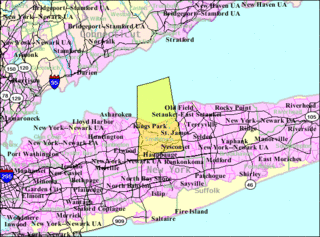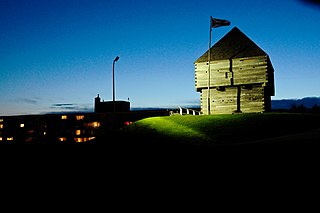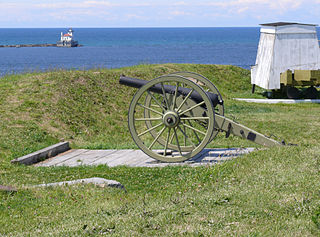Fort Salonga | |
| Nearest city | Fort Salonga, New York |
|---|---|
| Area | 0.2 acres (0.081 ha) |
| Built | 1776 |
| NRHP reference # | 82003406 [1] |
| Added to NRHP | May 21, 1982 |
Fort Salonga, also known as NYSDHP Unique Site No. A103-08-0036, is an archeological site in the vicinity of Fort Salonga, New York that was listed on the National Register of Historic Places in 1982. [1]

Fort Salonga is a hamlet and census-designated place (CDP) in Suffolk County, New York on the North Shore of Long Island. At the 2010 census, the CDP population was 10,008. The name evolved from the Revolutionary War-era British Fort Salonga, or Fort Slongo, once located near the border of the towns of Huntington and Smithtown, overlooking Long Island Sound.
It is the site of the Revolutionary War British Fort Salonga, or Fort Slongo, (named after one of the fort's architects – George Slongo [2] ) once located near the border of Huntington Township and The Town of Smithtown, overlooking the Long Island Sound.

The Town of Huntington is one of ten towns in Suffolk County, New York, United States. Founded in 1653, it is located on the north shore of Long Island in northwestern Suffolk County, with Long Island Sound to its north and Nassau County adjacent to the west. Huntington is part of the New York metropolitan area. As of the United States 2010 Census, the town population was 203,264.

Smithtown is a town in Suffolk County, New York, United States, on the North Shore of Long Island. This town is an eastern suburb of New York City. The population was 117,801 at the 2010 Census.

Long Island Sound is a tidal estuary of the Atlantic Ocean, lying predominantly between the U.S. state of Connecticut to the north, and Long Island in New York to the south. From west to east, the sound stretches 110 miles (177 km) from the East River in New York City, along the North Shore of Long Island, to Block Island Sound. A mix of freshwater from tributaries and saltwater from the ocean, Long Island Sound is 21 miles (34 km) at its widest point and varies in depth from 65 to 230 feet.

In an October 1781 skirmish between the British and Americans at the fort, Elijah Churchill, a soldier for the Continental Army, was wounded. He personally received a Badge of Military Merit from George Washington for his actions. The Badge became the Purple Heart and he is credited with being the first to receive the award. [3]
Elijah Churchill (1755–1841), was a soldier for the Continental Army during the American Revolutionary War.

The Continental Army was formed by the Second Continental Congress after the outbreak of the American Revolutionary War by the ex-British colonies that became the United States of America. Established by a resolution of the Congress on June 14, 1775, it was created to coordinate the military efforts of the Thirteen Colonies in their revolt against the rule of Great Britain. The Continental Army was supplemented by local militias and volunteer troops that remained under control of the individual states or were otherwise independent. General George Washington was the commander-in-chief of the army throughout the war.

The Badge of Military Merit was a military award of the United States Armed Forces. It is largely considered America's first military decoration, and the second oldest in the world. The award was only given to non-commissioned officers and privates. The Purple Heart is the official successor decoration of the Badge of Military Merit.














